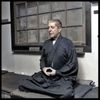11.6.2013 | 19:54
100 Benefits of Meditation
100 Benefits of Meditation
Physiological benefits:
1- It lowers oxygen consumption.
2- It decreases respiratory rate.
3- It increases blood flow and slows the heart rate.
4- Increases exercise tolerance.
5- Leads to a deeper level of physical relaxation.
6- Good for people with high blood pressure.
7- Reduces anxiety attacks by lowering the levels of blood lactate.
8- Decreases muscle tension
9- Helps in chronic diseases like allergies, arthritis etc.
10- Reduces Pre-menstrual Syndrome symptoms.
11- Helps in post-operative healing.
12- Enhances the immune system.
13- Reduces activity of viruses and emotional distress
14- Enhances energy, strength and vigour.
15- Helps with weight loss
16- Reduction of free radicals, less tissue damage
17- Higher skin resistance
18- Drop in cholesterol levels, lowers risk of cardiovascular disease.
19- Improved flow of air to the lungs resulting in easier breathing.
20- Decreases the aging process.
21- Higher levels of DHEAS (Dehydroepiandrosterone)
22- prevented, slowed or controlled pain of chronic diseases
23- Makes you sweat less
24- Cure headaches & migraines
25- Greater Orderliness of Brain Functioning
26- Reduced Need for Medical Care
27- Less energy wasted
28- More inclined to sports, activities
29- Significant relief from asthma
30- improved performance in athletic events
31- Normalizes to your ideal weight
32- harmonizes our endocrine system
33- relaxes our nervous system
34- produce lasting beneficial changes in brain electrical activity
35- Cure infertility (the stresses of infertility can interfere with the release of hormones that regulate ovulation).
Psychological benefits:
36- Builds self-confidence.
37- Increases serotonin level, influences mood and behaviour.
38- Resolve phobias & fears
39- Helps control own thoughts
40- Helps with focus & concentration
41- Increase creativity
42- Increased brain wave coherence.
43- Improved learning ability and memory.
44- Increased feelings of vitality and rejuvenation.
45- Increased emotional stability.
46- improved relationships
47- Mind ages at slower rate
48- Easier to remove bad habits
49- Develops intuition
50- Increased Productivity
51- Improved relations at home & at work
52- Able to see the larger picture in a given situation
53- Helps ignore petty issues
54- Increased ability to solve complex problems
55- Purifies your character
56- Develop will power
57- greater communication between the two brain hemispheres
58- react more quickly and more effectively to a stressful event.
59- increases one’s perceptual ability and motor performance
60- higher intelligence growth rate
61- Increased job satisfaction
62- increase in the capacity for intimate contact with loved ones
63- decrease in potential mental illness
64- Better, more sociable behaviour
65- Less aggressiveness
66- Helps in quitting smoking, alcohol addiction
67- Reduces need and dependency on drugs, pills & pharmaceuticals
68- Need less sleep to recover from sleep deprivation
69- Require less time to fall asleep, helps cure insomnia
70- Increases sense of responsibility
71- Reduces road rage
72- Decrease in restless thinking
73- Decreased tendency to worry
74- Increases listening skills and empathy
75- Helps make more accurate judgements
76- Greater tolerance
77- Gives composure to act in considered & constructive ways
78- Grows a stable, more balanced personality
79- Develops emotional maturity
Spiritual benefits:
80- Helps keep things in perspective
81- Provides peace of mind, happiness
82- Helps you discover your purpose
83- Increased self-actualization.
84- Increased compassion
85- Growing wisdom
86- Deeper understanding of yourself and others
87- Brings body, mind, spirit in harmony
88- Deeper Level of spiritual relaxation
89- Increased acceptance of oneself
90- helps learn forgiveness
91- Changes attitude toward life
92- Creates a deeper relationship with your God
93- Attain enlightenment
94- greater inner-directedness
95- Helps living in the present moment
96- Creates a widening, deepening capacity for love
97- Discovery of the power and consciousness beyond the ego
98- Experience an inner sense of “Assurance or Knowingness”
99- Experience a sense of “Oneness”
100- Increases the synchronicity in your life
Meditation is also completely FREE! It requires no special equipment, and is not complicated to learn. It can be practiced anywhere, at any given moment, and it is not time consuming (15-20 min. per day is good). Best of all, meditation has NO negative side effects. Bottom line, there is nothing but positive to be gained from it! With such a huge list of benefits, the question you should ask yourself is, “why am I not meditating yet?”
5.6.2013 | 17:08
Viðtal við Hemma Gunn þar sem hann ræði m.a. dauðann
,,Ég hef sem alkóhólisti farið í sjálfskoðunarferlið og það virkaði ljómandi vel á sínum tíma en það er ekkert í líkingu við þetta. Þarna breytast öll grunngildi algjörlega. Það sem skiptir máli eru börnin og sönn vinátta. Ég eltist ekki lengur við veraldleg auðævi. Eftir upprisuna fékk ég það sem ég var búinn að vera rembast við allt mitt líf, að reyna ná innri ró."
Hér fyrir neðan má hlusta á hljóðbút úr viðtali við Hemma en HÉR má lesa viðtalið í heild sinni.
4.6.2013 | 09:31
New to mindfulness? How to get started
Mindfulness is being used in schools, colleges and universities to help teachers and students to improve their attention, interactions with each other, and understanding of others.
Lawyers and judges use mindfulness to listen to and present evidence and reduce distractions. In other work settings, business leaders, workers and HR departments are using mindfulness training to reduce workplace stress, improve focus, communication, creativity and productivity.
And mindfulness is widely used in the treatment of mental disorders, such as depression and anxiety. It’s also used to assist people with medical conditions, such as diabetes, fibromyalgia, hypertension and insomnia and to improve the symptoms of stress.
If you’re new to mindfulness, you likely already have some understanding of what it is and its benefits. Now you’ve made a decision to try it.
Many people have heard the definition of mindfulness: paying attention in the present moment, on purpose, nonjudgmentally.
But if you don’t have access to a mindfulness training program through your work or through therapy, how do you start a mindfulness practice?
It’s hard to learn mindfulness on your own. It is possible, just as it’s possible to teach yourself to play the piano by reading books and practicing on your own. Mindfulness can be learned on your own through books, apps, YouTube videos and other resources.
However, like playing the piano or learning a sport, good instruction can significantly improve your learning.
And so, the first step to a mindfulness practice may be to research work programs, the possibility of accessing programs through your insurance or a mental health provider or mindfulness opportunities in your community. Many yoga classes or studios, for example, incorporate mindfulness into the practice or have a class that is devoted to mindfulness or meditation techniques.
But like a new exercise regime, once you’ve made the decision to try it, you may want to just get started.
If that’s the case, you can try the following exercise, which is an example of a mindfulness exercise.
- Choose a time when you have 10 minutes to yourself and find a quiet place to sit comfortably. Whether you are at your desk at work or in your home, clear the space of obvious distractions. Put away phones, email and other distractors. If setting a timer would help you stay focused, rather than worried about how much time you have, then set a timer.
- Acknowledge any thoughts or judgments you have about starting your mindfulness practice. You may be uncomfortable, skeptical or excited. Our minds are constantly thinking, so you may want to notice whether you are caught up in thoughts as you get ready for your practice. If this is the case, simply acknowledge thoughts and emotions that come into your awareness and then refocus on getting settled and comfortable.
- Once settled and comfortable, you can choose to close you’re eyes or keep your gaze focused in one spot in front of you. Take a few deep breaths and then begin by bringing your attention to your breath, as you breath in. Notice the tip of the nose as your breath enters your body. Continue to breathe normally, following your inhalations as your breath flows down into your lungs. Notice your lungs expand as your breath fills them and then notice them begin to contract during your exhalations. There is no need to change your breathing. Simply notice it as it flows in and out of your body.
- Follow your exhalations, with your awareness, as they flow out of your body. Notice your breath flowing from the lungs, up through airways and out your nose again.
- Continuing following your breath in this manner for 10 minutes. The first few times you practice, you may find that much of your time is spent lost in thought, rather than focused on your breath.
- The practice of mindfulness is about beginning to notice these internal distractions and mind wanderings and, once noticed, to bring your focus back. You may lose focus and bring your attention back many, many times over the course of several minutes. Don’t worry, this is part of the practice.
When you practice a piece on the piano, your fingers are more likely to find the right notes with repetition. In mindfulness, with practice and repetition, you will likely find that you are better able to keep your focus and are less distracted by thoughts and emotions that come up during your practice.
A piano teacher may help you to make a song come to life, by focusing on dynamics or by following the beat. In the same way, learning mindfulness with an experienced practitioner can help you to improve your practice.
One of the appealing aspects of mindfulness practice is that it can be integrated into daily life, but to do that, you need to have times when you formally practice, either with instruction or by intentionally setting time aside for it on your own. Research studies tend to find positive outcomes with 20 minutes of daily practice.
Simply becoming more aware might sound easy, but we often don’t realize how distracted we are in our lives. Retraining our minds takes time and effort, but it’s worth it. And what’s better to focus your awareness on than the everyday aspects of your life?
Sjá: http://psychcentral.com/blog/archives/2013/06/03/new-to-mindfulness-how-to-get-started/
28.5.2013 | 13:11
You will have to create the path by walking yourself ...
17:00 Leidd hugleiðsla (ítarleg kennsla á Kriya Yoga tækni), spurningar og svör.
Sjá betur hér: www.kriyayoga.is
23.5.2013 | 23:29
God knows the past, present and future
20.5.2013 | 13:04
Meditation Expert Peter Amato Announced Competition For Meditation In Schools Training
In an attempt to teach children how to live peacefully and forge a better future, Meditation Master Peter Amato has announced he will bring a meditation program to five deserving schools throughout the country, a $250,000 value in training and materials. At absolutely no cost to the schools.
By making meditation a regular part of the school day, Amato said, young children and teens will be given the tools to reduce stress in their lives, and cope with competition, peer pressure, bullying and the violence all around them. “Key research findings in pilot and current school meditation programs included increases in calm in the classroom, increased attentiveness, increase in a desire to learn along with a strong retention span, and an increase in morale and socialization. Overall, teachers saw a sizeable increase in emotional balance with less behavioral issues and acting out.”
Lesa greinina í heild sinni: http://www.digitaljournal.com/pr/1254712
Trúmál og siðferði | Breytt s.d. kl. 13:10 | Slóð | Facebook | Athugasemdir (0)
Um bloggið
OM - ॐ
Færsluflokkar
Tenglar
Hugleiðslunámskeið á Íslandi
- Námskeið hjá Hugleiðslu- og friðarmiðstöðinni
- Sahaja yoga-hugleiðsla
- Hugleiðslunámskeið hjá Brahma Kumaris
- Sri Chinmoy miðstöðin á Íslandi
- Andartak.is - Kundalini jóga og hugleiðsla
- Zen-hugleiðslunámskeið
- Dharma.is - Innsæishugleiðsla
- Innhverf íhugun
Frí hugleiðslunámskeið á Netinu
- Free Meditations
- Námskeið í búddískri hugleiðslu
- Námskeið í Kundalini yoga
- Free online meditation course
- Free Sahaja meditation course online
Hugleiðsla
Hér er að finna tengla þar sem þú getur lært og kynnt þér hugleiðslu.
- Listin að hugleiða
- Zen á Íslandi - Zen-hugleiðsla
- Kristbjörg
- Kundalini-hugleiðsla
- Hugleiðslu- og friðarmiðstöðin
- SGI-búddismi á Íslandi
- Sri Chinmoy miðstöðin á Íslandi
- Skandinavíski yoga- og hugleiðsluskólinn
- Leiðbeiningar fyrir Zen-hugleiðslu
- Sahaja Yoga
- Brahma Kumaris - Raja Yoga hugleiðsla
- Jack Kornfield - Insight Meditation (vipassana)
- Centerpointe
- Ljósmiðlun
- Traditional Yoga and Meditation of the Himalayan Masters
- Innhverf íhugun
- Vipassana meditation course
Helg forn rit
- Veda-ritin
- Bhagavad Gita
- Bhagavad Gita
- Upanishads
- Upanishads
- Shiva sutra
- Brahma Sutra
- Yogasútrur Patanjalis
- Rig Veda
- Sama Veda
- Hatha Yoga Pradipika
- Shiva Samhita
- Gheranda Samhita
- Sacred Texts (Helg indversk rit)
- Biblían
- Dhammapada
- Kóraninn
Tímarit um andleg málefni
- Tímaritið Knowledge of reality
- Bindu - Tímarit Skandinavíska yoga- og hugleiðsluskólans
- Tímaritið Gangleri
- Primary Point - Zen
- Efnisskrá Ganglera frá 1926
- The Sufism Journal online
- The Theosophist
Bækur á íslensku um andleg málefni
- Starfsrækt (Karma yoga) - Swami Vivekananda
- Allar bækur Gunnars Dal
- Bækur eftir Alice Baily
- Martínus - Bækur á íslensku
- Launviska Vedabóka
Bækur um andleg málefni
- The Unknown Life of Jesus Christ
- Bók um Kriya Yoga
- Sjálfsævisaga Jóga
- Whispers from Eternity - Paramahansa Yogananda
- The Path - Swami Kriyananda
- God is for Everyone - Inspired by Yogananda
- My time with the master - Paramahansa Prajnanananda
- The Universe Within - Paramahansa Prajnanananda
- The art and science of Raja Yoga - Swami Kriyananda
- Complete work of Swami Vivekananda
- Gopi Krishna - Bækur, greinar og viðtöl
- Bókin Zen and the brain
- Zen Mind, Beginner´s Mind - Shunryu Suzuki-roshi
- Manual of Zen Buddhisim - D. T. Suzuki
- Stripping the Gurus
- Rödd þagnarinnar á ensku
- Eckhart Tolle - Stillness Speaks - Hljóðbók
- Bækur eftir Ramana Maharshi
- Saundarya Lahiri
- The Meditative Mind - Krishnamurti
- Krishnamurti´s Notebook
- Meditations - Krishnamurti
- The Serpent Power
- C. W. Leadbeater - Chakras: A Monograph
- Kundalini Yoga - Swami Sivananda
- Fríar bækur með Krishnamurti
- The Tibetan Book of Dead
- Karma Yoga - Swami Vivekananda
- Leiðarljós (Light on the Path) á ensku
- The Power of Now - Hljóðbók
- Hljóðbókin Breath sweeps mind eftir Jakusho Kwong-roshi
- Opening the Hand of Thought Bók eftir Kosho Uchiyama
- To shine one corner of the world : moments with Shunryu Suzuki : stories of a Zen master told by his students
- How to Cook your Life - Dogen
- The Art of Just Sitting: Essential Writings on the Zen Practice of Shikantaza
- On Zen Practice
- On Having No Head
Greinar um andleg málefni
- Greinasafn Lífspekifélagsins/Guðspekifélagsins
- Greinar eftir Sigvalda Hjálmarsson
- Greinar og rannskóknir tengdar kundalini
- Krishnamurti - Greinar, viðtöl og tilvitnanir
- Hugleiðingar um kenningar Sigvalda Hjálmarssonar - I. Hluti
- Hugleiðingar um kenningar Sigvalda Hjálmarssonar - II. hluti
- Greinar úr zen-tímaritinu Primary Point
- Greinar eftir dr. Erlend Haraldsson
- Greinasafn Jóns L. Arnalds
- Yður er í dag frelsari fæddur? - Njörður P. Njarðvík
- Yoga og geðrækt
- Leiðin til hugljómunar - Sigvaldi Hjálmarsson
- Geinar úr tímaritinu Quest
Ýmsir tenglar andlegs eðlis - Íslenskir
- Kærleikssetrið
- Jógakennarafélag Íslands
- Lífspekifélagið/Guðspekifélagið
- AA
- CoDa
- Viska og gleði
- Kærleikssamtökin
- Björg Einarsdóttir
- Trú.is
- LAUSNIN - Baráttusamtök gegn meðvirkni
- Dharma.is - Innsæishugleiðsla
- Dulheimar - Andleg þróunarheimspeki
- Vetrarbrautin.com
- Listi yfir skráð trú- og lífskoðunarfélög á Íslandi
Ýmsir tenglar andlegs eðlis - Erlendir
- DharmaTalk með Thich Nhat Hanh
- Agni Yoga
- Meditation of the Himalayan Masters
- Vedanta Society
- Vedanta.com
- tantra-kundalini.com
- Ayurveda-próf - Hvaða líkamsgerð ertu?
- Prajnanamission
- Big Mind
- Vedanta Spiritual Library
- Great Integral Awakening
- Sounds True
- Wildmind - Buddhist Meditation
- Institute for Consciousness Research
- Biology of Kundalini
- Kundalini Research Network
- Hindu Tantrik Tradition
- Inner Self
- Spirit Voyage
- Dalai Lama kyrjar möntru úr Rig Veda
- Ýmislegt um Ramakrishna
- The Five Tibetan Rite
- Message from masters
- Bæklingur um sanskrítarframburð
- The Theosophical Society - International Headquarters
- Sri Vidya
- Vedanet
- Eastern tradition - Eastern Tradition Research Archive
- Lífspekifélög/Guðspekifélög um allan heim
Ýmsir andans menn
- Sigvaldi Hjálmarsson
- J. Krishnamurti
- Ken Wilber
- Gopi Krishna
- Swami Sivananda
- Osho
- Deepak Chopra
- Swami Vivekananda
- Sri Ramakrishna
- Yogi Hari
- Eckhart Tolle
- Yogi Shanti Desai
- Yogi Amrit Desai
- Shunryu Suzuki roshi
- Ramana Maharishi
- Sri Aurobindo
- Paramahansa Yogananda
- Paramahamsa Hariharananda
- Jakusho Kwong-roshi
- Jack Kornfield
- Swami Rama
- Grétar Fells
- D. T. Suzuki
- Dalai Lama
- Thich Nhat Hanh
- Eckhart Tolle
- Helena Blavatsky
- Paramahamsa Prajnanananda
- Rupert Spira
- Bodhidharma
- Om Swami
Lífspeki/Guðspeki
- Lífspekifélag Íslands
- Lífspekifélagið í USA
- Helena Blavatzky
- Facebook-síða Lífspekifélags Íslands
- Aðalstöðvar Lífspekifélagsins á Indlandi
Kriya Yoga
Hér er að finna tengla tengda Kriya Yoga
- Kriya Yoga Institute
- Paramahansa Hariharananda
- Paramahamsa Prajnanananda
- Bækur um Kriya Yoga eftir Hariharananda og Prajnananda
- Self-Realization Fellowship
- Ananda: The Teaching of Paramahansa Yogananda
- Cyberspace Ashram for Kriya Yoga
- Bókin Sjálfsævisaga jóga (Autobiography of a Yogi)
- Kriya Yoga - Swami Shankarananda Giri
- Kriya Yoga - Yogi Dhirananda
- Bók um Kriya Yoga á Netinu
- Kriya Yoga in the Lahiri Mahasaya family tradition
- Babaji´s Kriya Yoga
- Myndbönd um kriya yoga
- Prajnanamission
- Babaji Kriya Hatha Yoga - 18 Kriya Postures
- Umsókn - Kennslustundir hjá SRF
Hatha Yoga (Líkamsstöður - Teygjur)
- Yogavin
- Jóga hjá Kristbjörgu
- Jóga Stúdíó
- Jógakennarafélag Íslands
- Jóga Jörð
- Jen Reviews
- Sólir
- Yogashala
- Jógakennarar og jógastöðvar á Íslandi
Zen
- Zen á Íslandi
- Sonoma Mountain Zen Center
- Bókin Zen Mind, Beginners Mind eftir Shunryu Suzuki-roshi
- Bókin No Beginning. No End eftir Jakusho Kwong-roshi kennara Zen á Íslandi
- Hljóðbókin Breath Sweeps Mind eftir Jakusho Kwong-roshi
- The Teaching of Shunryu Suzuki-roshi
- San Francisco Zen Center
- Myndbönd með Suzuki-roshi
- Plum Village - Thich Nhat Hanh
- Zen of Recovery - Mel Ash
- Zen Road
- Zen sútrur
- Kwan Um School of Zen
- Daily Zen
- Big Mind
- Zen Peacemakers
- Suzuki-roshi 50
- Hljóðbókin Zen mind, beginner´s mind
- The Suzuki Roshi Audio Archive
- Opening the Hand of Thought Bók eftir Kosho Uchiyama
- To shine one corner of the world : moments with Shunryu Suzuki : stories of a Zen master told by his students
- How to Cook your Life - Dogen
- The Art of Just Sitting: Essential Writings on the Zen Practice of Shikantaza
- On Zen Practice
Bloggvinir
-
 thesecret
thesecret
-
 gudjonbergmann
gudjonbergmann
-
 gyda
gyda
-
 heringi
heringi
-
 gudmundurhelgi
gudmundurhelgi
-
 braxi
braxi
-
 fruheimsmeistari
fruheimsmeistari
-
 vilborg-e
vilborg-e
-
 steina
steina
-
 ludvik
ludvik
-
 maggadora
maggadora
-
 baenamaer
baenamaer
-
 perlaheim
perlaheim
-
 vestfirdir
vestfirdir
-
 vglilja
vglilja
-
 palmig
palmig
-
 einherji
einherji
-
 andreaolafs
andreaolafs
-
 flinston
flinston
-
 birnarebekka
birnarebekka
-
 tilfinningar
tilfinningar
-
 dizadj
dizadj
-
 gylforce
gylforce
-
 esa-emorea777
esa-emorea777
-
 estersv
estersv
-
 eydis
eydis
-
 gudjonelias
gudjonelias
-
 heildraent-joga
heildraent-joga
-
 heildraent-lif
heildraent-lif
-
 guru
guru
-
 tru
tru
-
 fun
fun
-
 jensgud
jensgud
-
 josira
josira
-
 katrinsnaeholm
katrinsnaeholm
-
 kari-hardarson
kari-hardarson
-
 kiza
kiza
-
 kjarvald
kjarvald
-
 kristinnhalldor
kristinnhalldor
-
 kiddirokk
kiddirokk
-
 krilli
krilli
-
 laufherm
laufherm
-
 mariaannakristjansdottir
mariaannakristjansdottir
-
 manisvans
manisvans
-
 nanna
nanna
-
 aronsky
aronsky
-
 huldumenn
huldumenn
-
 ragjo
ragjo
-
 rose
rose
-
 straitjacket
straitjacket
-
 vinur
vinur
-
 nimbus
nimbus
-
 slembra
slembra
-
 svanurg
svanurg
-
 toshiki
toshiki
-
 hanoi
hanoi
-
 thorhallurheimisson
thorhallurheimisson
Heimsóknir
Flettingar
- Í dag (9.6.): 0
- Sl. sólarhring: 4
- Sl. viku: 22
- Frá upphafi: 0
Annað
- Innlit í dag: 0
- Innlit sl. viku: 19
- Gestir í dag: 0
- IP-tölur í dag: 0
Uppfært á 3 mín. fresti.
Skýringar

![@[136336876521150:274:Sun Gazing]
Please Share](https://fbcdn-sphotos-c-a.akamaihd.net/hphotos-ak-ash3/s480x480/945211_449764151779941_693344742_n.jpg)





